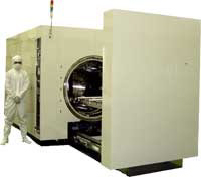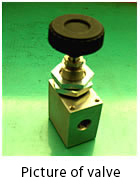- TopPage
- /
- Technology
Technology
Examples of Our Unique Technologies
■1.Technologies for combined use of vacuum and pressurization
Some of our equipment, such as high temperature pressure impregnation equipment and vacuum and pressure oven, utilize vacuum and pressurization processes in combination. Vacuum and pressurization provides minus and plus pressure respectively, which generally represents control of physical quantity contradictory to each other. For this reason, it is common that parts constituting equipment are separated into the ones for vacuum and ones for pressurization, and parts capable of supporting both processes can be hardly found on the market.
Combined use of both vacuum and pressurization allows for control of the inside of a pressure vessel in a manner that demerit of each process is compensated.
As we developed such technologies as our own unique technologies, we are presenting some of them in the following;

(1)Vacuum heat-treatment method and equipment
Common vacuum heat treatment equipment conducts heating after making the inside of vessel into vacuum state. However, our vacuum heat treatment equipment makes vacuum state after having raised temperature and attained uniform temperature distribution through heating under high pressure rather than atmospheric pressure, and that makes it possible to process work samples efficiently in a short time. With a usual vacuum oven, it took 5 hours to attain the target temperature of 140 degrees C in stable conditon. And the temperature error at 4 points was about 50 degrees C. . Our vacuum and pressure oven, however, yielded an excellent result that 140 degrees C was attained in stable conditon in about an hour and temperature error at 4 points was about 10 degrees C by conducting heating under pressure of 0.5MPa.
(2)Valve for vessels for combined use of decompression and pressurization
Valves for vacuum sold on the market have large caliber for air molecule to be exhausted efficiently, and the valves for pressurization have small caliber to keep flow rate constant and to ensure safety. Our newly invented valve has large caliber. To make the inside of pressure vessel into vacuum state (decompression), valve is opened and air is let out with a vacuum pump. Conversely, valve is closed to pressurize the inside of pressure vessel. The portion which serves as pressure vessel during pressurization is made thicker and stronger than the value obtained from calculation of intensity. Small-power motor is used to drive the valve so that the valve may not open at the time of a pressurization. Furthermore, a safety valve is installed to prevent effect on the lower part or vacuum pump even if the valve opened. This valve is necessary for the equipment that carries out both vacuum and pressurization processes.
(3)Sealing method for vacuum and high pressure chamber
Only atmospheric pressure is applied, at maximum, to gate valve used for vacuum when pressure is applied. However, for the gate valve used for pressurization, large pressure is applied and pressure leak takes place when the valve is opened or closed under vacuum state. It is, therefore, not suitable for use under vacuum state. So, we developed a new gate valve which can stand large pressure and can open or close under any conditon of vacuum, atmospheric pressure, and pressurization, as well.
(4)High temperature pressurization method and equipment for pressure vessel
When a pressure vessel is to be pressurized with air, generally air is successively forced into the vessel with a compressor. However, capacity and price are problems with the compressor. We have an experience of making an equipment by piling several systems to conduct compression with accumulator, in order to attain pressure of 40MPa. However, the equipment turned out to be large-scaled due to complicated structure and piping system, and it took several hours to actually attain 40MPa. In addition, there lie also problems such as humidity with air. So, we developed a new method to make the inside of pressure vessel into high pressure state in several seconds, by evaporating and expanding liquefied gas (nitrogen etc.) through heating with a heater.
(5)Valve
This valve uses Teflon material as valve seat to absorb friction generated by opening and closing of valve. Furthermore, since Teflon has high elasticity and stability, this valve can be used for fluid portions of vacuum to considerably high-pressure. The valve shown in the picture can stand the pressure from 10-4 Pa to 50MPa, and it is used for the equipment which carries out both vacuum and high-pressure processes.

■2.Feature of Pressure Vessel of Our Company
It is essential to manufacture pressure vessels according to the laws and regulations applicable in respective country, but it is also highly important to design them to assure easy operation and safety.
We design the pressure vessel with sufficient intensity so that they may not be broken even if 4 times as much pressure as that actually used is applied, through calculation of intensity. Gasket, lid and clutch ring (metal fixture fastening the lid) to seal pressure are of our original design and they will not be broken even if they are used for years, thus bringing greater safety. Compared with the usual clutch ring, our ring is highly airtight and safer thanks to the uniquely designed gasket and clutch ring mechanism. Gasket life can be also longer and it has been made possible to manufacture unique equipment capable of conducting pressurization as well as vacuuming in a single vessel.
Majority of lid opening-and-closing mechanisms are of bolt type, which makes it very difficult to open and close the lid manually when it comes to large-size equipment.
So, for large-size equipment, we automated operations of opening-and-closing of the lid and clutch ring, and loading products to be processed onto the equipment.